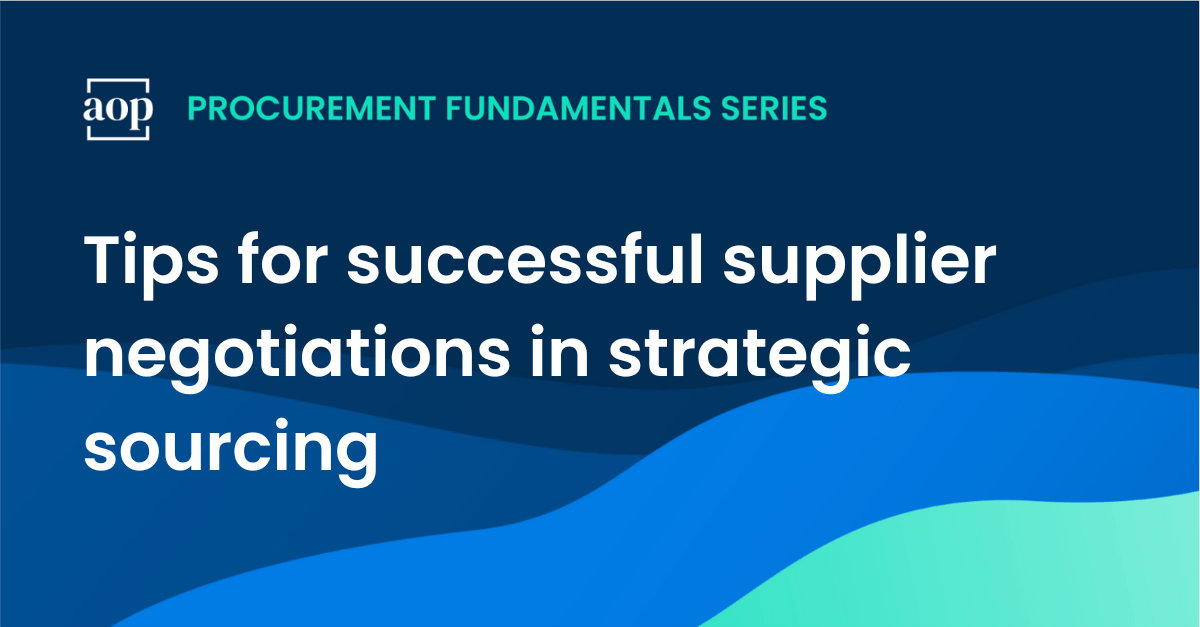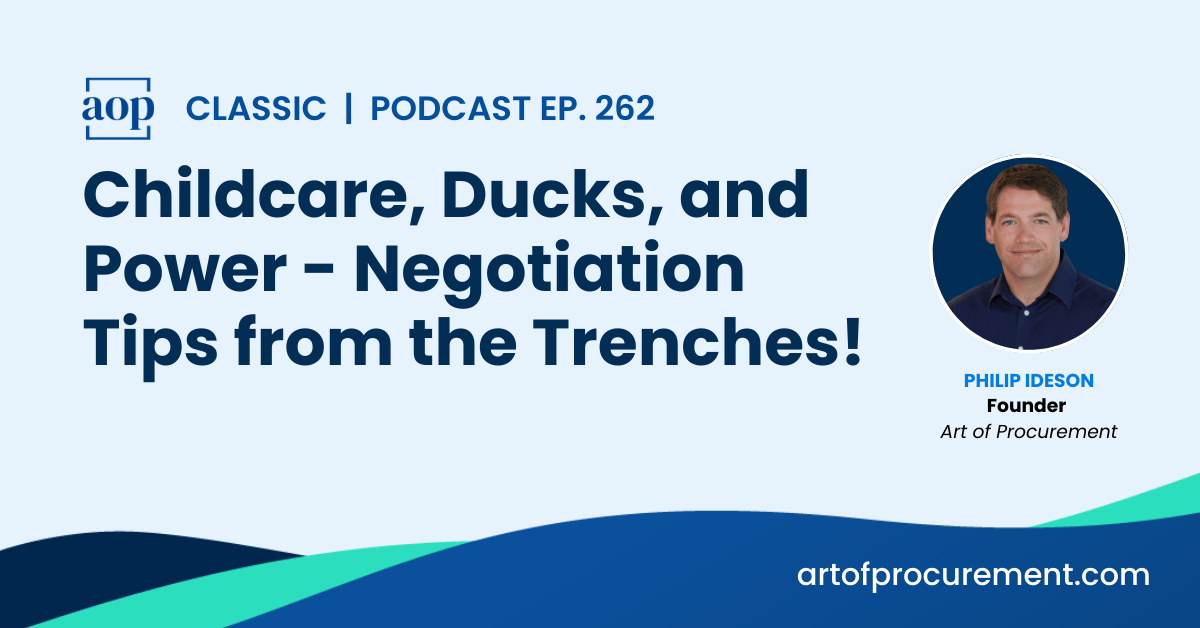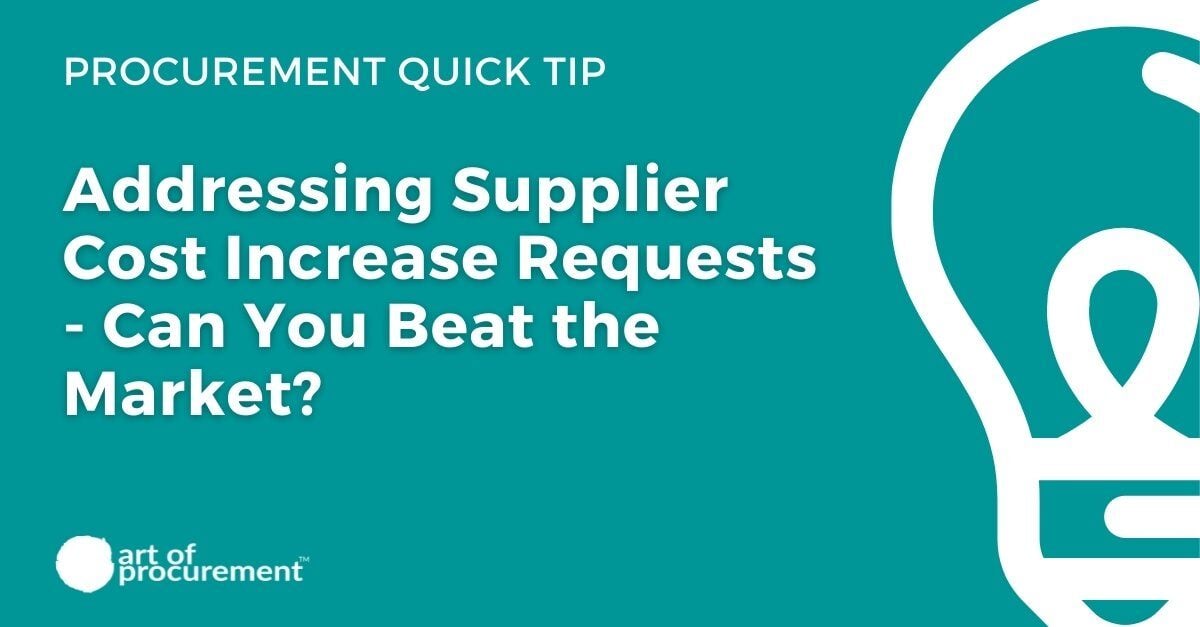8 min read
Tips for Successful Supplier Negotiations in Strategic Sourcing
Philip Ideson : April 10, 2025

As procurement professionals, our role isn’t to win at all costs. Instead, we should aim to create long-term value for everyone involved. Successful supplier negotiations require more than just tactics—they demand the right mindset, thoughtful preparation, and a clear understanding of strategic objectives and supplier dynamics.
Over the past two decades, I’ve negotiated billions of dollars’ worth of contracts both as a procurement practitioner and as a consultant. Here are my top tips for successful supplier negotiations in strategic sourcing.
A good negotiation process starts with planning
The most effective negotiation strategy begins with solid preparation and strong negotiation skills. Many procurement professionals, myself included, have occasionally rushed into supplier negotiations due to time constraints, without fully preparing.
Planning doesn’t need to be exhaustive, but it should clearly outline your negotiation objectives and must-have versus nice-to-have outcomes. Understanding these priorities beforehand empowers you to focus discussions strategically and make informed concessions. It also helps ensure you don’t lose sight of your ultimate goals under pressure.
The best approach to planning negotiations is to embed negotiations as part of a broader strategic sourcing initiative. Below I’ve outlined how it fits within my chosen 7-step strategic sourcing process.
How and where supplier negotiations fit within strategic sourcing
Before we go into the details, it’s good to see the big picture. Negotiation occupies a critical role as step six within my seven-step strategic sourcing process. At this stage, after you have identified opportunities, developed comprehensive category profiles, outlined sourcing strategies, selected suitable suppliers, and conducted RFx or auction processes, supplier negotiations commence to refine and finalize agreements.

Whether you follow my seven-step process or not, supplier negotiations are a key component of strategic sourcing, ensuring that all agreements align with your overall strategic objectives.
Seven types of negotiation strategies every procurement professional should know
Different negotiation situations call for different approaches. Luckily, there is a wealth of past academic material on the topic. Here are seven widely recognized types of negotiation you may have come across in business school:
1. Principled negotiation
This approach focuses on mutual interests, objective criteria, and fair outcomes. Procurement professionals using principled negotiation aim for results based on merit rather than pressure, personalities, or arbitrary demands. It's especially effective when long-term supplier collaboration is the goal.
2. Distributive negotiation
Often called “win-lose” or zero-sum negotiation, this style is used when one party’s gain is the other’s loss—typically in one-off transactions or highly commoditized buys. It is most often used in a competitive price-focused environment, where there is limited benefit associated with collaboration.
3. Integrative negotiation
Integrative negotiation—also known as win-win negotiation—is ideal when both parties are open to exploring multiple variables and creative trade-offs. It encourages collaboration to expand the total value of the deal, not just divide existing value. This is key in strategic sourcing where supplier partnerships are based on trust and mutual commitment.
4. Competitive negotiation
This style involves high assertiveness and low cooperativeness. It’s useful in situations where procurement holds significant leverage, such as when many suppliers are competing for the same business. However, overusing this tactic can harm supplier relationships in the long run.
5. Compromising negotiation
When time is limited or when both parties have equally strong positions, a compromising approach can lead to quick resolutions. Procurement teams should use this style carefully—compromises can lead to mediocre results if neither side gets what they truly need.
6. Multiparty or team negotiation
Many sourcing initiatives involve multiple stakeholders or cross-functional teams. In these scenarios, managing internal alignment is just as important as negotiating with the supplier. Coordinating messaging, priorities, and objectives is essential for a unified negotiation front.
7. Accommodating negotiation
This cooperative style is about maintaining a relationship, sometimes at the expense of short-term gains. Procurement may adopt this approach with strategic suppliers during sensitive times, such as a supply chain disruption. It helps reinforce trust but should be balanced to avoid being taken advantage of.
While these negotiating approaches can give you a reference point, you’re unlikely to find that modern-day supplier relationships follow such a simple choice of negotiation strategy.
A win-win mindset matters in modern-day supplier negotiations
When entering any negotiation, it’s important to start with a win-win mindset. This doesn’t mean compromising on your key objectives, nor does it suggest that you should leave value on the table. Instead, it’s about identifying areas where concessions can genuinely benefit your supplier without negatively impacting your company. It’s about finding common ground that makes both parties feel satisfied with the outcomes.
Early in my career, I viewed supplier negotiations as more of a zero-sum game, focused on getting the maximum value for the company at the minimum cost. Over time, I realized that this approach often misses significant opportunities to create deeper partnerships and can even damage critical relationships. Starting negotiations with a collaborative mindset can yield better outcomes—improving supplier engagement, securing priority service, and ultimately adding more value for your business.
Close the information gap with fact-based negotiations
Suppliers usually have an information advantage in negotiations because they deal with similar transactions daily. To level the playing field, procurement should actively seek additional sources of insight. Whether speaking directly with subject matter experts, reviewing market intelligence reports, or leveraging spend analysis data, any step you take to increase your market understanding will improve your negotiating position.
Fact-based negotiation is a proactive approach where procurement professionals ground their discussions in objective, verifiable data rather than relying on subjective or emotional arguments. They use market benchmarks, industry trends, historical spend data, and competitive intelligence to strengthen their credibility and negotiation stance.
Even when the insights you gather aren’t perfect, directionally accurate market data serves as a vital starting point in negotiations. It signals to your supplier that you’re informed, serious, and ready for productive discussions.
The power of transparency in supplier negotiations
Transparency might feel counterintuitive in negotiations, especially when it involves sharing sensitive information like budgets. Procurement teams often hesitate to disclose budgets up front, concerned that suppliers might inflate their pricing accordingly. However, thoughtful transparency can actually facilitate more effective negotiations.
In certain conditions, you can even go so far as to share budget frameworks. Sharing budget details can enable suppliers to offer tailored solutions, potentially identifying cost savings or creative options your team hadn't considered. It shifts the dialogue from price-driven bargaining to collaborative problem-solving, improving trust and paving the way for innovative solutions.
Tips for effective contract negotiation
Contract negotiation is a cornerstone of successful supplier relationships. It goes beyond merely agreeing on terms; it’s about crafting a contract that prevents disputes, ensures compliance, and fosters a collaborative relationship. Here’s how to achieve effective contract negotiation:
- Start sooner rather than later: Waiting until all price negotiations are complete before introducing contract terms into the conversation is a missed opportunity. Procurement should share their standard contract language as soon as possible - potentially even during the RFx process.
- Clearly define scope and deliverables: Start by outlining the scope of work, deliverables, and timelines in detail. This clarity helps prevent misunderstandings and sets clear expectations for both parties.
- Establish key performance indicators (KPIs): Define KPIs to measure supplier performance objectively. These metrics ensure that both parties are aligned on what success looks like and provide a basis for performance reviews.
- Negotiate competitive pricing: Ensure that the pricing is fair and competitive. This involves understanding market rates and negotiating terms that reflect the value provided by the supplier.
- Define payment terms and conditions: Clearly outline payment terms, including schedules, methods, and any penalties for late payments. This transparency helps avoid financial disputes.
- Establish a dispute resolution process: Include a clear process for resolving disputes. This could involve mediation, arbitration, or other methods that both parties agree upon.
By following these steps, businesses can ensure their contracts are comprehensive, fair, and aligned with their strategic objectives, laying the groundwork for successful supplier relationships.
Negotiation tactics to secure more favorable terms
It’s not just what you negotiate about, but how you negotiate that can lead you to a positive outcome. Here are a few quick tactics that can unlock more value from your supplier negotiations:
- Anchor negotiations with credible data: Start discussions with credible, data-driven market insights. Anchoring your positions in objective data, whether on competitive pricing, industry trends, or raw material costs, strengthens your stance and reduces subjective debates.
- Use the 70/30 rule: A golden rule for any negotiation is that you spend 30% of your time talking and 70% of your time listening. The more time you spend listening, the better you will understand how you can turn your supplier into an ally.
- Offer structured concessions: Identify ahead of time the concessions you’re prepared to make—particularly those that suppliers genuinely value but have minimal cost implications for your organization. This can include improved payment terms, flexible delivery schedules, or promotional support (testimonials, case studies, etc.). Structured concessions lead suppliers to reciprocate positively, creating an environment conducive to beneficial outcomes.
- Focus on relational incentives: Highlighting relational benefits—such as testimonial opportunities, referrals, or joint ventures—can significantly enhance negotiation outcomes. These incentives often mean as much or more to suppliers than strictly monetary benefits, particularly when long-term strategic goals are involved.
Ultimately, the way you negotiate can not just bring favorable terms, but also ensure long-term supplier commitment.
Overlooked supplier negotiation points
While procurement teams frequently focus on obvious negotiation points, like price and immediate contractual terms, several overlooked factors can substantially impact supplier negotiation outcomes:
- Avoid RFP reliance:
Many procurement professionals rely heavily on the RFP process as their primary source of market insight. But the responses you receive through an RFP are shaped by the specific questions you’ve asked and may not fully reflect market realities. - Must-have vs. nice-to-have:
Clearly identifying your must-have requirements versus the nice-to-have items streamlines negotiations significantly. Procurement professionals often attempt to secure all possible terms, diluting focus and creating unnecessary friction. - Understand supplier motivations beyond profit:
Profit maximization isn't the only driving force behind supplier decisions. Suppliers also value relational incentives, such as opportunities to expand into new markets, co-marketing agreements, testimonials, or collaborations on product innovation.
Recognizing these often-overlooked aspects of supplier negotiation not only improves immediate outcomes but also positions your procurement team as strategic partners, enhancing your overall supplier relationship management.
Negotiating ethically builds stronger supplier relationships
Ethics matter greatly in procurement negotiations. In my own career, I’ve been on both sides of discussions where questionable tactics or less-than-truthful claims were used to justify positions. These practices never result in sustainable outcomes. Eventually, the truth emerges, leading to damaged relationships and lost trust.
Maintaining ethical standards doesn't weaken your negotiating position—quite the opposite. Ethical negotiations build credibility, establish trust, and lead to stronger, more resilient supplier relationships. This trust creates a foundation for future negotiations, making each subsequent interaction more productive and beneficial.
By embracing these core principles—starting with the right mindset, planning carefully, proactively addressing information-based disadvantages, and committing to ethical standards—procurement professionals can significantly enhance their negotiation outcomes.
Aim for long-term supplier partnerships
Long-term supplier partnerships don't happen accidentally—they’re strategically built through careful, intentional negotiations. Procurement teams need to proactively identify potential suppliers whose capabilities and business objectives align closely with their organization's strategic direction. Once identified, actively nurture these relationships through regular interactions, consistent communication, and collaborative problem-solving approaches.
Suppliers who see genuine commitment from procurement teams reciprocate with loyalty, flexibility, and greater willingness to innovate. Such strong relationships typically result in better negotiated terms, quicker resolutions to supply chain disruptions, and valuable insights into emerging industry trends.
Post-negotiation best practices
Post-negotiation best practices can ensure that each agreement is implemented effectively and that the relationship with the supplier is maintained. Here are some key steps to follow:
- Document agreements: Ensure that all agreements are documented and signed by both parties. This documentation serves as a reference and helps prevent misunderstandings.
- Establish a communication plan: Create a clear communication plan to keep both parties informed of progress and any issues that arise. Regular communication helps maintain transparency and trust.
- Monitor supplier performance: Track supplier performance against agreed KPIs. Monitoring performance ensures that the supplier meets the contractual terms and delivers the expected quality and service.
- Conduct regular reviews: Hold regular review meetings to discuss progress, address issues, and identify opportunities for improvement. These reviews help maintain alignment and foster continuous improvement.
- Foster a collaborative relationship: Build a collaborative relationship with the supplier based on trust, respect, and open communication. A strong relationship can lead to better problem-solving and innovation.
- Continuously improve: Evaluate and improve the negotiation process regularly. Learning from each negotiation helps refine your approach and enhances future negotiations.
By following these steps, you can ensure that their negotiations are successful and that your relationships with your suppliers are maintained and strengthened over time.
Bottom line on supplier negotiations in strategic sourcing
Negotiation isn’t just a checkpoint in the sourcing process—it’s a strategic capability. When done right, it becomes a lever for long-term value creation, stronger supplier relationships, reduced risk, and greater alignment with your organization’s goals.
The most successful procurement professionals don’t treat negotiations as one-off events or battles to be won. They approach them with the right mindset, backed by preparation, facts, and a commitment to transparency and ethics. They understand that every negotiation is an opportunity to build trust, unlock new value, and set the tone for a partnership that can evolve and grow.
Whether you’re finalizing a contract, securing favorable terms, or forging a high-impact supplier alliance, how you negotiate matters. Strategic sourcing isn’t complete without a structured, thoughtful negotiation process at its core—and your ability to lead that process is what will set you apart.
Related articles and resources:
- Strategic Sourcing, Explained for Beginners
- How to Start a Strategic Sourcing Process (with My Proven 7-Step Plan)
- How to Create a Category Profile for Strategic Sourcing
- How to Build A Strategic Sourcing Strategy (that Goes Beyond Category and Supplier Management)
- Learn How Google’s Strategic Sourcing Team Became a Trusted Business Partner, with Tim Jones of Google.






